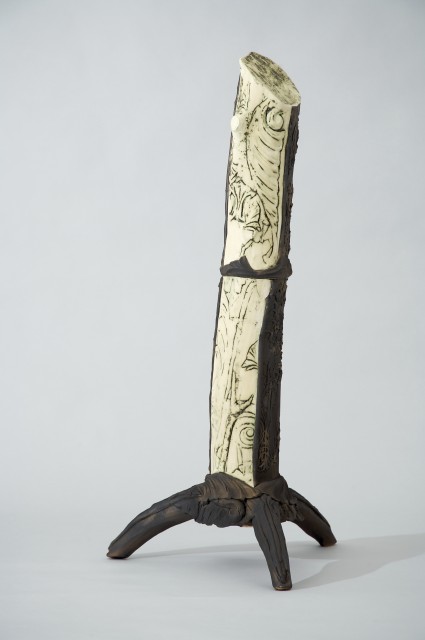In 2006 I began to photograph the flood-damaged banks of the Red and Assiniboine Rivers that meet in downtown Winnipeg. Focusing primarily on the Assiniboine River in the Osborne Bridge area, the photographs show the intense patterning of the deeply cracked earth and the many devastated trees that are revealed when the floodwaters recede. The floods and resulting erosion along the banks of the rivers in Winnipeg, provide a perennial testament to the unrelenting force of nature. The uprooted trees, either ripped out of the ground by the sheer velocity of moving water, or succumbing to a more gradual erosion of their foundation over time, and those left standing, bearing clear witness to the rising waterline, serve as reminders of the overwhelming power of the natural environment. However, in Winnipeg, the immediate backdrop to this natural phenomenon is the city. As human beings who are urban dwellers living in downtown Winnipeg, we are constantly negotiating this balance between nature and culture.
In an attempt to address the dual nature of existence in the centre of the city, and the constant reminder that all that exists is vulnerable to the ravages of time, I have begun to create ceramic trees. Broken and cut fragments of trees that have been destroyed and left to deteriorate are collected and cast in plaster. Once the plaster moulds are made, they are used as press moulds. Embedded into the walls of the rebuilt ceramic trees are traces of branches, leaves and veins, a record or memory of the trees’ former existence. In addition to organic symbols, there are ornamental motifs pressed into the clay, based on those found on the historic buildings in downtown Winnipeg. As most of the architectural ornamentation on Winnipeg’s heritage buildings was fabricated from either wood or terra cotta, there is an ironic link established between tree, wood, architecture, and my ceramic pieces that mimic all of these. The leap made from source to finished artwork is not a large one, but an important transformation takes place none-the-less, as my ceramic trees embody artifice, a culturalized representation of trees, bearing improbable markings, surfaces, and embellishments.
To highlight the gap between the organic and the artificial, the natural and the human-made, I have begun to wrap the trees in a new bark made up of text. Certain poignant words such as “devastated” and “remembered”, or the Latin versions, devastatus, devastare, rememorari or memoria are repeated over and over again to create a new kind of bark for the trees. Although fragmented, broken, and chaotic like the devastated trees, with all legibility and clarity muddled, the new textual bark is resonant of some type of regeneration. And if not able to be convincing of regeneration or re-growth, at the very least, there is an acknowledgement of the potential for recovery. The ceramic trees, with all their scars, wounds, cuts, broken bark, embedded bits of organic matter, fragments of architectural details, and monochromatic or charred surfaces, stand as memorials to a former existence – one rooted in another time and place.
Photography by William Eakin.
